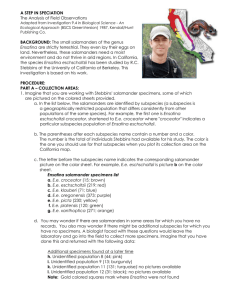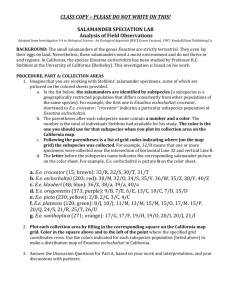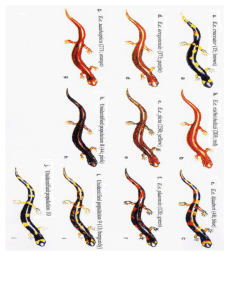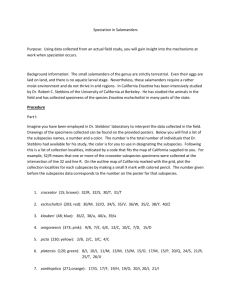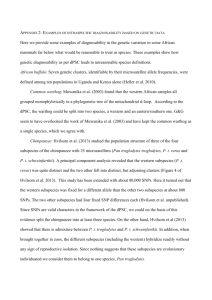Salamander speciation activity
advertisement
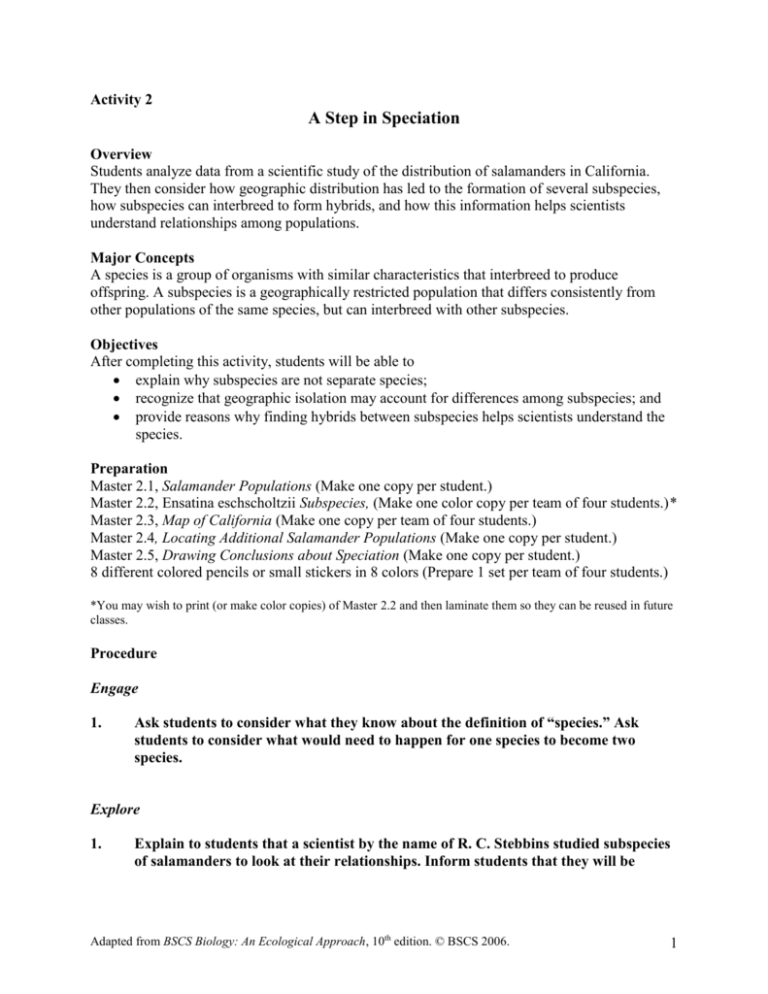
Activity 2 A Step in Speciation Overview Students analyze data from a scientific study of the distribution of salamanders in California. They then consider how geographic distribution has led to the formation of several subspecies, how subspecies can interbreed to form hybrids, and how this information helps scientists understand relationships among populations. Major Concepts A species is a group of organisms with similar characteristics that interbreed to produce offspring. A subspecies is a geographically restricted population that differs consistently from other populations of the same species, but can interbreed with other subspecies. Objectives After completing this activity, students will be able to explain why subspecies are not separate species; recognize that geographic isolation may account for differences among subspecies; and provide reasons why finding hybrids between subspecies helps scientists understand the species. Preparation Master 2.1, Salamander Populations (Make one copy per student.) Master 2.2, Ensatina eschscholtzii Subspecies, (Make one color copy per team of four students.)* Master 2.3, Map of California (Make one copy per team of four students.) Master 2.4, Locating Additional Salamander Populations (Make one copy per student.) Master 2.5, Drawing Conclusions about Speciation (Make one copy per student.) 8 different colored pencils or small stickers in 8 colors (Prepare 1 set per team of four students.) *You may wish to print (or make color copies) of Master 2.2 and then laminate them so they can be reused in future classes. Procedure Engage 1. Ask students to consider what they know about the definition of “species.” Ask students to consider what would need to happen for one species to become two species. Explore 1. Explain to students that a scientist by the name of R. C. Stebbins studied subspecies of salamanders to look at their relationships. Inform students that they will be Adapted from BSCS Biology: An Ecological Approach, 10th edition. © BSCS 2006. 1 examining data and drawing conclusions about whether the data support the currently accepted view of one species with seven subspecies. If students need a definition for the term subspecies, define it as “a geographically restricted population that differs consistently from other populations of the same species.” 2. Divide the class into groups of three or four students. Give each student a copy of Master 2.1, Salamander Populations. Give each team a copy of Master 2.2, Ensatina eschscholtzii Subspecies, and a copy of Master 2.3, Map of California. Have students follow the directions on Master 2.1 and plot the locations of the different subspecies on the map. 3. After teams have had time to plot the data and answer the questions, discuss the questions with the class. Explain 1. Again ask students to work in their teams again to continue with their data analysis. Give each team of students a copy of Master 2.4, Locating Additional Salamander Populations. As before, ask students to plot the locations on the map and answer the questions at the bottom of the page. 2. Ask students to share their answers to the questions Elaborate 1. Ask students to recall the hybrids that were found in several locations. Ask students to recall that the hybrids were found in areas where two subspecies were in close proximity to each other. 2. Ask students to look at their maps. Point out the populations of E. e. eschscholtzii and E. e. klauberi. Also point out the populations of E. e. platensis and the specimens of E. e. xanthoptica found at location 19/O. Challenge students with the following question: “Would you expect to find hybrids between these species where the populations of the different subspecies overlap? Have students explain their answers. 3. Explain to students that scientists have found hybrids between E. e. platensis and E. e. xanthoptica but that E. e. eschscholtzii and E. e. klauberi do not interbreed. Ask students to consider why some subspecies interbreed and others do not. Evaluate 1. Conclude the activity by asking students to work in their teams to answer the questions on Master 2.5, Drawing Conclusions about Speciation. Adapted from BSCS Biology: An Ecological Approach, 10th edition. © BSCS 2006. 2 Sample answers to questions Adapted from BSCS Biology: An Ecological Approach, 10th edition. © BSCS 2006. 3 Master 2.1, Salamander Populations The small salamanders of the genus Ensatina are strictly terrestrial. They even lay their eggs on land. Nevertheless, these salamanders need a moist environment and do not thrive in arid regions. The following table gives locations where salamanders of different subspecies of Ensatina eschscholtzii have been found. Plot the locations for the different subspecies on the map. Use the specified colors to identify each subspecies on the map. Picture on Master 2.2 Subspecies a E. e. crocreator Number of Salamanders Found 15 b E. e. eschscholtzii 203 c E. e. klauberi 48 d E. e. oregonensis 373 e E. e. picta 230 f E. e. platensis 120 Locations 32/R 32/S 30/T 31/T 30/M 32/O 34/S 35/V 36/W 35/Z 38/Y 40/Z 36/Z 38/a 40/a 39/a 9/B 7/E 6/E 13/C 10/C 7/D 15/D 2/B 2/C 3/C 4/C 8/J 10/J 11/M 13/M 15/M 15/O 17/M 15/P 20/Q 24/S 21/R 25/T 26/U Adapted from BSCS Biology: An Ecological Approach, 10th edition. © BSCS 2006. Color for Plotting Data Brown Red Blue Purple Yellow Green 4 g E. e. xanthoptica No salamanders found 271 17/G 17/F 19/H 19/O 20/I 20/J 21/I 11/I 14/I 17/K 19/K 22/N 26/Q 5/M 32/U 32/a 35/f Orange Black After you have plotted the data on the map, work with your team members to answer the following questions. 1. Is the species uniformly distributed? Use your knowledge of the species’ ecological requirements to offer an explanation of its distribution. Are there any other factors that might affect distribution? 2. Consider the topography of California as shown on the map. Does the species seem more characteristic of mountain areas or of valley areas? 3. Do you expect any pattern in distribution of subspecies? Why or why not? 4. Examine the salamanders pictured on Master 2.1. Note that some subspecies have yellow or small orange spots on a black background. There are other differences as well. For example, some have white feet. Refer to the distribution map you created. Does there appear to be any order to the way these color patterns occur in California? For example, do the spotted forms occur only along the coast? Do spotted forms occur in the north and unspotted ones in the south? 1. Subspecies E. e. eschscholtzii and E. e. klauberi are different from each other. What relationship is there between their distributions? Adapted from BSCS Biology: An Ecological Approach, 10th edition. © BSCS 2006. 5 Master 2.2, Ensatina eschscholtzii Subspecies Scientists have found seven subspecies of Ensatina eschscholtzii in California. A subspecies is a geographically restricted population that differs consistently from other populations of the same species. The pictures below show representatives from each of the subspecies and individuals from other populations in California. Adapted from BSCS Biology: An Ecological Approach, 10th edition. © BSCS 2006. 6 Master 2.3, Map of California Adapted from BSCS Biology: An Ecological Approach, 10th edition. © BSCS 2006. 7 Master 2.4, Locating Additional Salamander Populations You may wonder if there are salamanders in some areas for which you have no records. You also may wonder if there might be additional subspecies for which you have no specimens. A biologist faced with these questions would leave the laboratory and go into the field to collect more specimens. Imagine that you have done so and returned with the following data. Picture on Master 2.2 b Subspecies E. e. eschscholtzii Number of Salamanders Found 16 c E. e. klauberi 23 h Unidentified population 8 44 i Unidentified population 9 13 k Unidentified population 11 131 l Unidentified population 12 31 Locations 36/Z 41/Z 33/M 34/W 34/U 40/b 40/Z 36/a 4/I 5/H 7/H 7/F 6/J 9/F 28/T 27/T 26/T 28/S 29/T 23/J 24/K 24/L 29/M 25/J 25/L 6/C 7/C 6/B Color for Plotting Data Red Blue Black and green Black and red Black and blue Black and yellow Work with your team members to answer the following questions. 1. According to Stebbins, the unidentified populations are not additional subspecies. What, then, is the probably genetic relationship of populations 8, 9, and 11 to the subspecies plotted on the map? 2. On this basis, describe the appearance you would expect specimens of population 11 to have. Adapted from BSCS Biology: An Ecological Approach, 10th edition. © BSCS 2006. 8 3. Why is it unlikely that you would ever find individuals combining characteristics of E. e. picta and E. e. xanthoptica? 4. Look at the distribution of the original collections of E. e. eschscholtzii and E. e. klauberi. What reasons were there for trying to collect additional specimens from extreme southern California? 5. How do the results of additional collections differ from the results in other places where two different populations approach each other? 6. Imagine that, while examining salamanders in another collection, you find specimen j from population 10 shown on Master 2.2. Compare its characteristics, especially the spotting pattern, with those of the named populations. Also, consider the distribution of these populations. Between which two is this specimen most likely a hybrid? Adapted from BSCS Biology: An Ecological Approach, 10th edition. © BSCS 2006. 9 Master 2.5, Drawing Conclusions about Speciation Work with your team members to answer the following questions. 1. In a brief paragraph, explain why Stebbins concluded that there is only one species of Ensatina in California? 2. Bear in mind the biological definition of a species and also the appearance and distribution of the named populations of Ensatina. Which one of these populations could be considered a species separate from E. e. eschscholtzii? Why? 3. Suppose volcanic activity in northern California should become violent and completely destroy all salamanders in that region. How would this event affect the species Ensatina? 4. If E. e. picta most closely resembles the ancestor species of Ensatina, where do you think the ancestors lived? Adapted from BSCS Biology: An Ecological Approach, 10th edition. © BSCS 2006. 10
